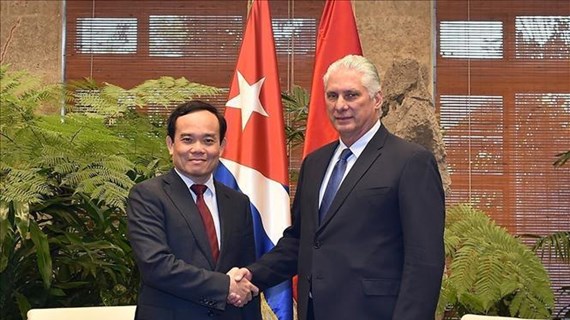Despite rising sales, soaring input costs crimp sectors
Surmounting the tensest period caused by the COVID-19 pandemic, a number of enterprises have regained growth momentum. However, rising input costs are affecting their performance.
 Garment 10 Corporation is stepping up production and export (Photo: VietnamPlus)
Garment 10 Corporation is stepping up production and export (Photo: VietnamPlus)However, rising fuel prices, along with logistic costs, have slowed business growth. In particular, slower growth in such major industries such as electronics, textile - garment, and leather - footwear may cause substantial impact on macro-economic indexes and the economy’s competitiveness.
Data of the Ministry of Industry and Trade show that the textile - garment and leather - footwear sectors posted double-digit growth rates in the first half of 2022. But many businesses are still reluctant to expand operation.
Faster growth recorded
After two consecutive years of the COVID-19 pandemic, the Garment 10 Corporation is speeding up manufacturing to fulfill orders.
General Director Than Duc Viet said the number of orders his company received has risen by about 15% from the same period last year. There are considerable orders for such products as jackets and shirts.
The most encouraging signs in the first six months came from the apparel purchasing power in large markets like Europe, Japan and, especially, the US, which has bounced back strongly.
Vuong Duc Anh, Chief of the Office of the Board of Directors at the Vietnam National Textile and Garment Group (VINATEX), said while the purchasing power was eroded by the pandemic, consumers in the US have been spending more on shopping, leading to a surge in the apparel import demand in the first quarter of 2022.
Textile - garment exports to the US hit 7.58 billion USD in the first five months of 2022, rising 26.1% and making up 57% of these commodities’ total export growth, according to the General Department of Vietnam Customs.
The Vietnam Textile and Apparel Association (VITAS) noted textile - garment remained a major contributor to the country’s export growth in the first half of this year.
Vietnam earned 22.3 billion USD from exports during January - June, up 23% from a year earlier. That included nearly 7 billion USD in apparel, up 19%. This has resulted in a trade surplus of some 8.8 billion USD for the sector in the first half.
The textile - garment sector targets 43 billion USD in export revenue for 2022, and over 50% of that target was met in the first six months. If markets stay stable in the remaining months, this year’s target is completely within the reach, said VITAS Vice Chairman Truong Van Cam.
Likewise, leather and footwear businesses have also seen positive signs. Many have received orders to fulfill until the end of the third quarter, even the fourth.
Growth in the first half of 2022 was “very good”, there is now a relatively big number of orders, according to Phan Thi Thanh Xuan, Vice Chairwoman and Secretary General of the Vietnam Leather, Footwear and Handbag Association (LEFASO).
Great pressure from input costs
 Footwear products of the Ha Tay Chemical - Weave Company present in many big markets. (Photo: VietnamPlus)
Footwear products of the Ha Tay Chemical - Weave Company present in many big markets. (Photo: VietnamPlus)Garment 10 Corporation chief Viet said input costs have grown, but it is hard for enterprises to hike prices at the same pace with surges in input costs.
In addition, up to 50% of the textile - garment materials have to be imported from China. The northern neighbour is sticking to its zero-COVID policy, triggering a materials shortage in the short term and adding to import expenses.
Estimates by VINATEX show that due to higher logistics costs caused by soaring fuel prices, sea transportation expenses are forecast to go up by some 10 - 30%. Domestic transportation expenses are also predicted to rise by about 10%.
A further headache is the growing congestion at seaports due to limited capacity and rising transportation demand after the pandemic. This has substantially impacted enterprises.
Pham Xuan Hong, Chairman of the Ho Chi Minh City Textile, Garment and Embroidery Association, predicted that growth may slow down in the year-end months due to the Russia - Ukraine conflict, disrupted material supply, and high input costs.
Phan Thi Thanh Xuan also noted leather, footwear, and handbag manufacturers are facing great pressure from surging input costs. Expenses on a container of exports almost doubled at certain points in time.
Small- and medium-sized enterprises are struggling with finding material supply, but the situation has improved in recent months as China has become more open, she said./.













